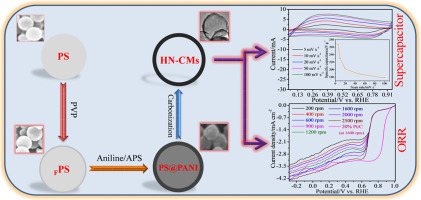当前位置:
X-MOL 学术
›
J. Electroanal. Chem.
›
论文详情
Our official English website, www.x-mol.net, welcomes your
feedback! (Note: you will need to create a separate account there.)
Polyaniline–derived metal–free hollow nitrogen–doped carbon microspheres as an efficient electrocatalyst for supercapacitors and oxygen reduction
Journal of Electroanalytical Chemistry ( IF 4.1 ) Pub Date : 2018-11-01 , DOI: 10.1016/j.jelechem.2018.09.051 Mobashar Hassan , Dandan Wu , Xuedan Song , Weiwei Qiu , Qing Mao , Suzhen Ren , Ce Hao
Journal of Electroanalytical Chemistry ( IF 4.1 ) Pub Date : 2018-11-01 , DOI: 10.1016/j.jelechem.2018.09.051 Mobashar Hassan , Dandan Wu , Xuedan Song , Weiwei Qiu , Qing Mao , Suzhen Ren , Ce Hao

|
Abstract To design a highly efficient electrocatalyst for cathodes to suppress the high overpotential for the oxygen reduction reaction (ORR) continually remains a prime goal of fuel cell study. Herein, the production of metal–free hollow nitrogen–doped carbon microspheres (HN–CMs) as an efficient electrode material for the supercapacitors and ORR in an alkaline media is reported. Initially, the PS@PANI core–shell microspheres were produced by coating polyaniline (PANI) layers on polyvinylpyrrolidone (PVP) functionalized polystyrene (PS) microspheres via in–situ chemical polymerization of aniline monomers in presence of ammonium persulphate (APS) as an oxidant. Finally, the core was removed by carbonizing the core–shell microspheres under the N2 atmosphere at 500 °C for 2 h to obtain the HN–CMs as an electrocatalyst. The structure and morphologies of the microspheres were examined by SEM, TEM, XRD, FT–IR, BET, and Raman spectroscopy. The electrochemical analysis was performed by CV, GCD, and EIS. The obtained electrocatalyst exhibited improved electrochemical performances for supercapacitors application and demonstrated better electrocatalytic activity for ORR. For this electrocatalyst, the maximum specific capacitance of 266.7 F g−1 was obtained in 1 M KOH at scan rate of 5 mV s−1. Additionally, it has superior catalytic activity and stability via 4-electron process during ORR in the alkaline solution. The contribution of highly intact spherical/hollow structure, good surface area, and large contents of graphitic/pyridinic nitrogen of HN–CMs can improve the mass transportation by facilitating the diffusion pathways which results in the enhancement of its electrochemical and electrocatalytic properties. As a metal–free and cost–effective electrode material, this is supposed to be promising for supercapacitors and fuel cells.
中文翻译:

聚苯胺衍生的无金属空心氮掺杂碳微球作为超级电容器和氧还原的有效电催化剂
摘要 设计一种高效的阴极电催化剂以抑制氧还原反应(ORR)的高过电位一直是燃料电池研究的主要目标。本文报道了在碱性介质中生产无金属空心氮掺杂碳微球(HN-CMs)作为超级电容器和 ORR 的有效电极材料。最初,PS@PANI 核壳微球是通过在过硫酸铵 (APS) 作为氧化剂的存在下,通过苯胺单体的原位化学聚合,在聚乙烯吡咯烷酮 (PVP) 官能化聚苯乙烯 (PS) 微球上涂覆聚苯胺 (PANI) 层来制备的. 最后,通过在 N2 气氛下在 500°C 下碳化核-壳微球 2 小时来去除核,以获得 HN-CM 作为电催化剂。通过SEM、TEM、XRD、FT-IR、BET和拉曼光谱检查微球的结构和形貌。电化学分析通过 CV、GCD 和 EIS 进行。所获得的电催化剂在超级电容器应用中表现出改善的电化学性能,并表现出更好的 ORR 电催化活性。对于这种电催化剂,在 1 M KOH 中以 5 mV s-1 的扫描速率获得了 266.7 F g-1 的最大比电容。此外,它在碱性溶液中的 ORR 过程中通过 4 电子过程具有优异的催化活性和稳定性。高度完整的球形/中空结构的贡献,良好的表面积,HN-CMs 中大量的石墨/吡啶氮可以通过促进扩散途径来改善质量传输,从而增强其电化学和电催化性能。作为一种不含金属且具有成本效益的电极材料,这有望用于超级电容器和燃料电池。
更新日期:2018-11-01
中文翻译:

聚苯胺衍生的无金属空心氮掺杂碳微球作为超级电容器和氧还原的有效电催化剂
摘要 设计一种高效的阴极电催化剂以抑制氧还原反应(ORR)的高过电位一直是燃料电池研究的主要目标。本文报道了在碱性介质中生产无金属空心氮掺杂碳微球(HN-CMs)作为超级电容器和 ORR 的有效电极材料。最初,PS@PANI 核壳微球是通过在过硫酸铵 (APS) 作为氧化剂的存在下,通过苯胺单体的原位化学聚合,在聚乙烯吡咯烷酮 (PVP) 官能化聚苯乙烯 (PS) 微球上涂覆聚苯胺 (PANI) 层来制备的. 最后,通过在 N2 气氛下在 500°C 下碳化核-壳微球 2 小时来去除核,以获得 HN-CM 作为电催化剂。通过SEM、TEM、XRD、FT-IR、BET和拉曼光谱检查微球的结构和形貌。电化学分析通过 CV、GCD 和 EIS 进行。所获得的电催化剂在超级电容器应用中表现出改善的电化学性能,并表现出更好的 ORR 电催化活性。对于这种电催化剂,在 1 M KOH 中以 5 mV s-1 的扫描速率获得了 266.7 F g-1 的最大比电容。此外,它在碱性溶液中的 ORR 过程中通过 4 电子过程具有优异的催化活性和稳定性。高度完整的球形/中空结构的贡献,良好的表面积,HN-CMs 中大量的石墨/吡啶氮可以通过促进扩散途径来改善质量传输,从而增强其电化学和电催化性能。作为一种不含金属且具有成本效益的电极材料,这有望用于超级电容器和燃料电池。




















































 京公网安备 11010802027423号
京公网安备 11010802027423号